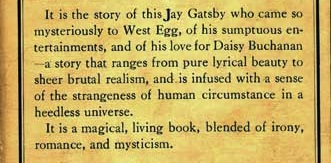 In the world of rare and antiquarian book collecting, an original dust jacket will greatly increase the value of a book over the same book without its original dust jacket. Because of this fact, it is also a fact that some unscrupulous booksellers may be tempted to counterfeit dust jackets in order to turn a profit. There are steps you can take to identify a knock-off dust jacket.
In the world of rare and antiquarian book collecting, an original dust jacket will greatly increase the value of a book over the same book without its original dust jacket. Because of this fact, it is also a fact that some unscrupulous booksellers may be tempted to counterfeit dust jackets in order to turn a profit. There are steps you can take to identify a knock-off dust jacket.
What you’ll need
If you’re serious about building your collection of rare books, your first investment, if you haven’t done so already, should be in a simple lighted pocket microscope. You can get one adequate enough for the task at hand, for as little as $10, or go for a more high-end pocket microscope for around $40. Most standard pocket microscopes will magnify 60X – 100X, which is more than sufficient for your purposes.
Inkjet versus Offset Lithographic Printing
The biggest indicator of a counterfeit dust jacket will be the appearance of the ink. An inkjet printer operates exactly like its name sounds—by spraying (or jetting) the ink onto the surface. Even extremely high-end professional inkjet printers will present telltale signs, though they might be somewhat more difficult to spot.
Dust jackets on antiquarian books will have been printed by offset lithographic printing. The first main difference to point out is how the ink is applied. Whereas with ink-jetting, the ink is sprayed onto the paper, with offset lithography, the ink is pressed onto the paper. This creates a number of resulting difference between the two methods.
Ink that has been pressed onto the surface of the paper will have thicker and more defined edges, for one, as the ink when pressed onto the paper gets pushed outward.
The other difference you will notice when examining inkjet versus lithography with a pocket microscope is the shape, size and pattern of the dots. The dots created by an inkjet printer will be much smaller and will also appear to have a random pattern (because they do). Conversely, the dot patterns produced by offset lithographic printing will present themselves with fuzzy yet well-defined shapes (circular or geometric).
Areas that are not a solid color, but made up of two or more colors, will display the most apparent signs of either inkjet or offset lithography because the multiple colors will make identifying dots and their patterns a little easier. An inkjet print will have much more defined color separation.
Flaw Facsimiles
If the dust jacket is said to be 100 years old and the paper looks, feels and smells brand spankin’ new, assume that it is. Even the most well-preserved antiquarian dust jacket will show signs of its antiquity. Check for wear at the creases and the edges.
It’s important to run your hand over any flaws that you may see, to determine if these are in fact flaws. Why? Because a facsimile that was created using an original dust jacket will have reproduced its flaws. If you see what appears to be a crinkle, a scratch, an abrasion, a small tear, etc., then these things should be apparent to the touch as well.
This brings me to another point. Beware of a dust jacket that does not match the size of the book perfectly. Examine the book thoroughly because a dust jacket that is smaller than the book is an indication that you may be looking at a dust jacket that has been cropped to disguise a facsimile of the actual worn edges on the original.
When in doubt, ask
When examining a book, should you have any doubts about its authenticity, do not be afraid to ask pointed questions. While a seller may be selling the book with a reproduction dust jacket for the purpose of display, an honest bookseller will make this known upfront. For example, we recently sold a Signed First Gone With The Wind which had a facsimile dust jacket on it, since the original one from 1936 is hard to find.
So if you’re not sure, don’t be afraid to ask, and be sure to get your answer as well as a money back guarantee in writing. The best thing to do, of course, is to only deal with reputable booksellers who offer both a guarantee of authenticity and an ironclad money back guarantee.
A note about The Great Gatsby (pictured at the top)
An original dust jacket for The Great Gatsby (1925) by F. Scott Fitzgerald is one of the most highly sought after and valuable antiquarian dust jackets. This is because the “j” in Jay Gatsby on the back flap was mistakenly printed in lower case, and each copy corrected by hand with ink by the publisher.
Was this article helpful? Leave your comments below.

Leave a Reply